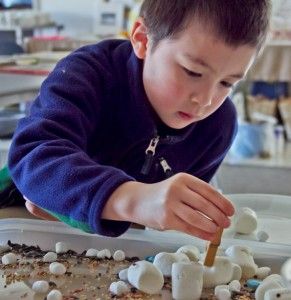Fossil hunters remembered at Darwin’s celebration

February 12, 2012
The “mother of paleontology,” Mary Anning, is rarely mentioned in history books. Neither is William Smith, the “father of geological mapping.” But both made discoveries that inspired Charles Darwin to develop his theory of evolution.
Joyce Webb, the keynote speaker at Darwin’s 203rd Birthday Celebration held Saturday at the Carbondale Unitarian Fellowship, said Anning and Smith, both working-class 19th century Englishmen, shared more than anonymity. Both shared a passion for fossils, and their efforts to uncover and map ancient life promoted the study of natural history.
The event was part of worldwide Darwin Day celebrations to recognize science and reason and was one of several events held during February in Carbondale, said Candy Davis, the event organizer.
Advertisement
The Carbondale Unitarian Fellowship started Darwin’s local birthday celebration four years ago to honor his contributions to the scientific community, Davis said.
The singing duo Parsley & Sagebrush, along with the Unitarian Folk Orchestra, played evolutionary music for guests. Hosts served primordial soup and Devonian Darwinian desserts and children played games such as “Pin the Beak on the Finch.”
Frank Anderson, associate professor of zoology, held an “Ask Dr. Andy” session at the celebration during which he answered questions about evolution, genetic sequencing and how DNA research has supported Darwin’s theories.
Anderson said Darwin’s theory of evolution is the best explanation that science has for diversity and adaptation found in plant and animal species.
“Darwin would be amazed at how much the processes he was describing would be confirmed by DNA,” Anderson said.
Webb said her studies of Darwin and his theory of evolution led her to research Mary Anning and Wiliam Smith.
She said Anning, a fossil hunter who lived in southern England on what is now known as the Jurassic Coast, discovered the first fossil evidence of a plesiosaur, a long-necked marine reptile, embedded in the coast’s layers of sedimentary rocks.
Advertisement*
Webb said several years later, Anning discovered fossils of flying reptiles and prehistoric fish, as well as many invertebrate fossils.
Anning sold her fossils to biologists and historians throughout England and on the European continent but was never credited with their discovery by any of the important scientists because of her gender, Webb said.
“Some of the leading scientists in the world would come and “fossil” with Mary, but they wouldn’t give her credit when they got home,” Webb said.
Smith fared little better in receiving credit for uncovering the rich fossil record of the British Isles and mapping it, Webb said.
Smith, a canal worker, was very interested in the layers of sedimentary rocks lining the canals. He noticed each layer contained different fossil types and created a geological map that identified the layers of rock based on the fossils they contained.
“There were no fossil-based geology maps in the world until his,” Webb said.
But Smith didn’t receive the credit he deserved for his work until much later in his life, Webb said, because of his low social status. He was eventually recognized for his achievements by the Geological Society of London.
Darwin used both the works of Anning and Smith in his research on evolution.
“Darwin credited Smith, but not Mary,” Webb said.
Advertisement








